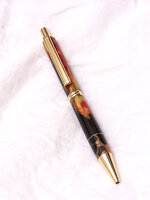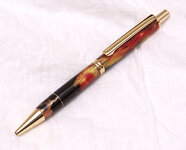I use CA . Once the surface is sealed you can sand but try not to cut through the finish .
Take what Butch said, print it out in BIG letters and put it above the lathe! DAMHIKT! :biggrin:
I am hearing people saying not to sand? Ok, so what do people use to finish? CA and MM or something else? I hear some metals can react to some finishes.
You can sand but it introduces problems!
The problem with sanding is that it will sand the metal as well as the wood. IF you have an all metal pen, you probably won't have a problem. But with metal and wood, the metal sanding dust dulls the wood and it looks like pencil lead or worse. It is hard to get off - but it can be done - except it is a pain. Some use different kinds of liquid - Denatured alcohol, acetone, or other. And some use compressed air and blow them off.
So, How do we get around sanding?
The best way is to prevent the metal sanding dust smears in the first place. That is done as mentioned above by Butch and me. Spend some extra time sharpening the chisel of choice and use that. About every minute or so, swipe the chisel on the hone to keep it sharp. Turn the lathe at fairly high speed 3000+ RPM, take little bitty bits, clean the chisel, swipe it on the hone, take more small bits. Hone the chisel again. Don't be aggressive and don't rush. Think of it as "finess" shaping from the beginning. As experience is gained, you can speed up a little but not by much. To me, the results are worth the discipline of this technique.
I use the scraper but it doesn't do well on medium soft or soft woods. It does do excellent on hard and stabilized woods. I think that the Skew is the best, but I still have not mastered it to perfection yet, so I stay with the scraper.
This technique will bring the wood and metal segments to a very smooth surface. Use Calipers to determine the size instead of the bushings. Once the final size (that is needed) is achieved, Use CA. Apply several layers of CA to build up enough so that you will NOT sand through to the wood when finishing. IF you do sand through, get your scraper or skew out and lightly touch the area or whole blank to pull the CA off - down to the wood and start the CA finish again. Some woods will show a coloration difference once you sand through/scrape through the CA finish, but some don't. Those that do - I take the finish off and start over. Butch doesn't have this problem - he is that good! :biggrin: And I am not kidding!


